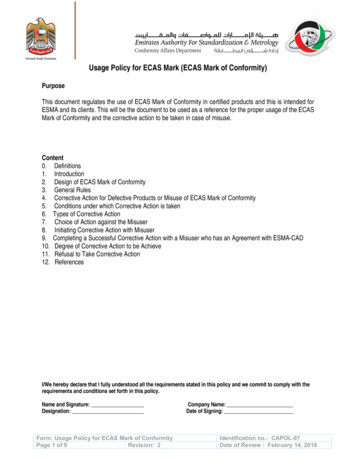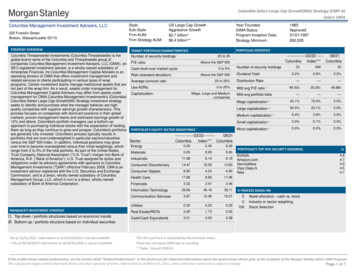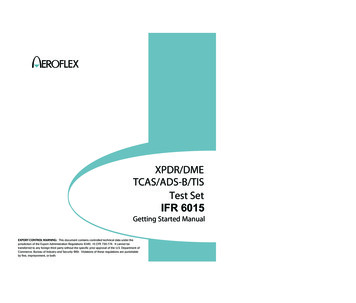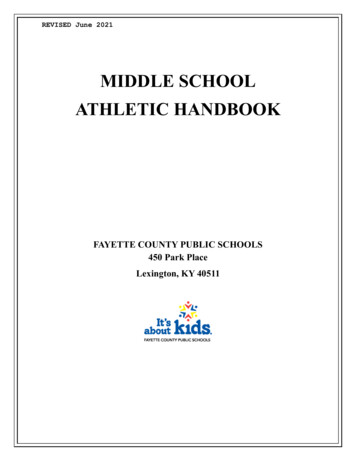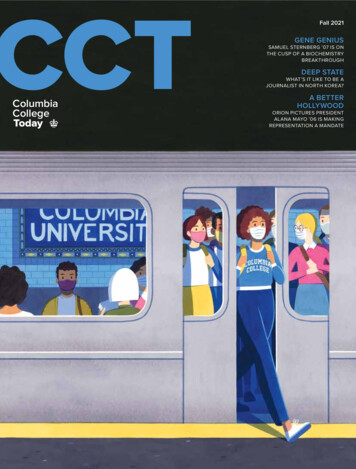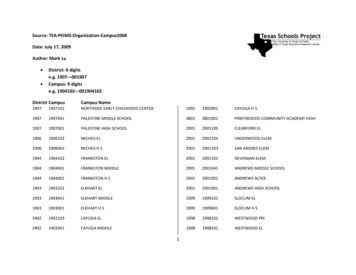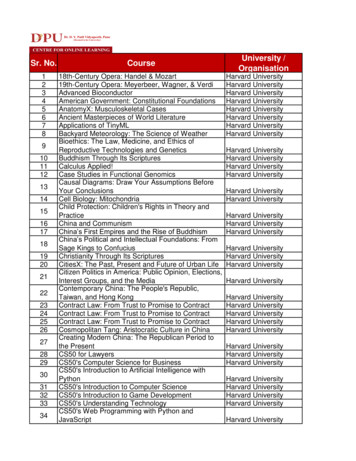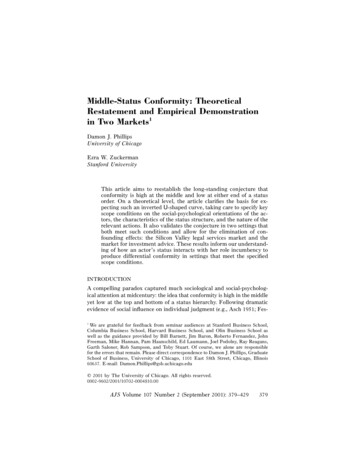
Transcription
Middle-Status Conformity: TheoreticalRestatement and Empirical Demonstrationin Two Markets1Damon J. PhillipsUniversity of ChicagoEzra W. ZuckermanStanford UniversityThis article aims to reestablish the long-standing conjecture thatconformity is high at the middle and low at either end of a statusorder. On a theoretical level, the article clarifies the basis for expecting such an inverted U-shaped curve, taking care to specify keyscope conditions on the social-psychological orientations of the actors, the characteristics of the status structure, and the nature of therelevant actions. It also validates the conjecture in two settings thatboth meet such conditions and allow for the elimination of confounding effects: the Silicon Valley legal services market and themarket for investment advice. These results inform our understanding of how an actor’s status interacts with her role incumbency toproduce differential conformity in settings that meet the specifiedscope conditions.INTRODUCTIONA compelling paradox captured much sociological and social-psychological attention at midcentury: the idea that conformity is high in the middleyet low at the top and bottom of a status hierarchy. Following dramaticevidence of social influence on individual judgment (e.g., Asch 1951; Fes1We are grateful for feedback from seminar audiences at Stanford Business School,Columbia Business School, Harvard Business School, and Olin Business School aswell as the guidance provided by Bill Barnett, Jim Baron, Roberto Fernandez, JohnFreeman, Mike Hannan, Pam Haunschild, Ed Laumann, Joel Podolny, Ray Reagans,Garth Saloner, Rob Sampson, and Toby Stuart. Of course, we alone are responsiblefor the errors that remain. Please direct correspondence to Damon J. Phillips, GraduateSchool of Business, University of Chicago, 1101 East 58th Street, Chicago, Illinois60637. E-mail: Damon.Phillips@gsb.uchicago.edu䉷 2001 by The University of Chicago. All rights reserved.0002-9602/2001/10702-0004 10.00AJS Volume 107 Number 2 (September 2001): 379–429379
American Journal of Sociologytinger, Schachter, and Back 1950; Sherif 1935), a series of studies indicatedthat the force of such social control varies, producing an inverted U-shaped(IUS) relationship between status and conformity (Blau 1960, 1963; Dittesand Kelley 1956; Harvey and Consalvi 1960; Homans 1961; Menzel 1960;see also Ranulf 1938). As explained by Dittes and Kelley (1956), conformityincreases as actors value their membership in a group yet feel insecurein that membership. Since high-status actors feel confident in their socialacceptance, they are emboldened to deviate from conventional behavior(Hollander 1958, 1960). At the same time, low-status actors feel free todefy accepted practice because they are excluded regardless of their actions. Finally, in contrast to the relative freedom experienced by highand low-status actors, middle-status conservatism (compare Homans1961, pp. 357–58) reflects the anxiety experienced by one who aspires toa social station but fears disenfranchisement. Such insecurity fuels conformity as middle-status actors labor to demonstrate their bona fides asgroup members.Interestingly, despite its intuitive appeal and advocacy by prominentscholars, the conjecture of an IUS relationship between status and conformity never gained wide acceptance, and relevant research all but ceasedin the 1970s. Studies of the diffusion of innovation devoted the mostsustained attention to this idea, in the form of tests of a U-shaped relationship between status and innovation. But such tests generated contradictory findings that were never resolved. In particular, medical diffusionresearchers favored an elaboration of this U-shaped curve proposed byBlau (1963, p. 202; also see Marsh and Coleman 1956; Menzel 1960) andsupported by Becker (1970); that is, high-status actors are more likely toadopt innovations that mesh with prevailing group norms, while lowstatus actors originate counternormative innovations. By contrast, agricultural diffusion scholars discarded the notion of such a U-shaped relationship upon finding that groups of low socioeconomic status (SES)lag in adopting innovations. Instead, debate raged over whether the positive relationship between SES and innovation is linear or cubic (Cancian1967, 1979; Gartrell 1977).The IUS conjecture also failed to gain firm footing in other relevantresearch traditions. For instance, while social psychologists were prominent contributors to early work on this idea (e.g., Dittes and Kelley 1956;Harvey and Consalvi 1960; Hollander 1958, 1960), they subsequentlyshifted focus from the question of how status determines action to theanalysis of the ways various actions and characteristics confer status orinfluence (e.g., Moscovici and Nemeth 1974; Ridgeway 1978, 1981; Wahrman and Pugh 1972, 1974). At the same time, network research has centered on the channels through which social contagion occurs rather thanon variation in susceptibility to contagion (e.g., Marsden and Friedkin380
Middle-Status Conformity1993; but see Galaskiewicz and Burt 1991, p. 100). Finally, the idea ofan IUS relationship between status and conformity never attracted interestin the criminological literature despite comments and findings that areconsistent with such an idea (Nye, Short, and Olson 1958; Matza andSykes 1961, p. 715; Hagan, Gillis, and Simpson 1985, p. 1155; Jensen andThompson 1990, p. 1017; also see Veblen [1899] 1960, p. 160). Indeed, thevery notion of white-collar crime (Sutherland 1983) echoes the distinctionbetween normative and counternormative innovation found in the medical diffusion literature. Nevertheless, debate in criminology has beenframed around the question of whether the relationship between classand deviance is linear (e.g., Tittle, Villemez, and Smith 1978; Jensen andThompson 1990; Tittle and Meier 1990; Hagan 1992) rather than whetherthere might be a curvilinear association between status and deviance.The failure of the IUS conjecture to take hold likely stems from interrelated theoretical and empirical difficulties. Theoretically, the assumptionof three social ranks—high, middle, and low—is troubling because it seemsrather arbitrary. Any well-developed theory on the relationship betweenstatus and conformity must clarify why there could not be more or fewerstatuses. Perhaps the most serious theoretical difficulty with the IUS hypothesis derives from a failure to delineate clear scope conditions anddefine key concepts, thus dooming it to contradictory results. For example,the mixed findings in the diffusion literature might lead one to reject theIUS conjecture. However, it is possible that differences in operationalization—for example, the variables taken as indicators of innovation andstatus—may account for the different findings. Without clearer guidelineson applying the IUS conjecture in particular contexts, contradictory results are inevitable.The main empirical challenge to demonstrating an IUS curve relationship between status and conformity lies in disentangling the effects ofstatus from those of other stratifying variables. For example, to the extentthat status correlates with quality or ability and the behavior in questionis regarded as an indicator of performance, middle-ranked actors mayappear to act more conventionally simply because such actors perform atan average level.2 Similarly, if the action in question requires the possession of certain resources and higher status actors are more resourceful,then the lowest rank’s failure to conform may simply reflect an inability,rather than a lack of social pressure, to do so (Han 1994). Finally, effects2Below, we also discuss recent economic models that have proposed specific theoriesof “herding” and “countersignalling” based on differences in ability.381
American Journal of Sociologyof social rank can often be attributed to differences in information access.3To the extent that high- and low-ranked actors have more extragroup tiesthan do those of the middle rank, they enjoy greater exposure to alternative practices and are thus more likely to adopt them (Weimann 1982).In this article, we aim to shed greater light on the relationship betweenstatus and conformity. First, we develop a theoretical framework thataddresses the central difficulties in past formulations. The heart of ourmodel is the observation that an actor may occupy only one of threepossible locations with respect to a given social boundary that divides themembers and nonmembers of a desirable social designation: one may beon the inside, on the outside, or on the dividing line. Those who straddlethis boundary—actors who tend to be viewed as middling in status—workfeverishly to solidify their social standing by demonstrating their conformity with accepted practice.A key feature of our theoretical restatement of the IUS conjecture isthe identification of scope conditions on actors’ social-psychological orientations, on the nature of the status hierarchy, and on the type of actionsinvolved. Such restrictions appear to define a rather narrow range ofcontexts in which it is appropriate to expect a curvilinear relationshipbetween status and conformity. Accordingly, the second objective of thisarticle is to analyze two settings that do fall within this range—the SiliconValley legal market and the market for investment advice—and to examine two relevant actions—the opening of a family law practice and theissuing of a “sell” recommendation. These settings are attractive becausethey allow for the examination of the effect of social rank independentof other stratifying variables. In addition, as we discuss below, economicmarkets such as the ones we study are relatively simple social settingsthat are more likely to satisfy the scope conditions. Ironically, while theIUS curve has not previously been documented in a market context, ouranalysis suggests that the market constitutes a particularly good settingin which to explore traditional sociological thinking on status and roledynamics.4 In what follows then, we pursue two objectives: first, to reestablish the IUS conjecture, being careful to provide scope conditions and3A related problem is that an actor’s status, which reflects position in networks ofevaluation, typically correlates with his integration or centrality in networks of interaction (Burt 1982, pp. 199–203; Coleman, Katz, and Menzel 1966, pp. 111–12). Indeed,many scholars use status and integration interchangeably (e.g., Blau 1960; Menzel1960; Becker 1970).4The partial exception is Han (1994). However, Han understands his results as reflecting an opinion-leadership process. In addition, his analysis of the selection ofauditors cannot disentangle the effect of status from that of differential resources.Nevertheless, his analysis is largely consistent with the IUS curve.382
Middle-Status Conformityguidelines for empirical application, and second, to demonstrate its presence in two markets that do fall within that range.THEORETICAL FRAMEWORKThe Candidate-Audience InterfaceFollowing Zuckerman (1999, pp. 1401–3), consider an interface betweenone set of actors, termed candidates, who seeks entry into relations witha second set of actors, termed the audience. Candidates present offers tothe audience, and the latter select their preferred offer. That is, candidatesand audience members stand opposite one another in a role relationshipin which a candidate’s role incumbency is contingent, not given. Candidates compete with one another to align their “announcements” of identity with the audience’s “placements” (see Stone 1962).It is useful to characterize the audience’s selection process as consistingof two ideal-typical phases, which are mirrored in two stages of candidatebehavior.5 In the first stage, the field is set. In order to make their choice,audience members must be able to compare competing offers with oneanother. To the extent that a given offer hinders the audience’s ability tocalibrate an offer against the others, it will be screened out of competitionand ignored. Such offers are impure (Douglas 1966) or illegitimate (Meyerand Rowan 1977; DiMaggio and Powell 1983) in the sense that theythreaten the existing system of classification. The need for comparabilityis such that the interface collapses if offers are so different from oneanother as to make cross-offer comparison impossible (White 1981a).Thus, rather than optimizing over the full menu of alternatives, the audience limits its attention to a discrete consideration set of like alternatives(e.g., Shocker et al. 1991; Urban, Weinberg, and Hauser 1996). This choiceprocess on the part of the audience pressures candidates to orient theiroffers to the comparative frame employed by the audience. In order tohave a chance at having its offer accepted, a candidate must demonstratethat its offer conforms to the criteria that define members of the audience’sconsideration set, lest it be ignored as unintelligible.The second phase begins once illegitimate offers have been eliminatedand only those candidates recognized as full-fledged players remain. Atthis point, audience members compare the players’ offers with one anotherand select the one they perceive as best. Mirroring such triage, playerslabor to distinguish their offers from one another to gain selection by5While we discuss the two phases as occurring sequentially through time, this is aconceptual distinction rather than an empirical one. The stages of conformity/classification and differentiation/evaluation are temporally intertwined.383
American Journal of Sociologyaudience members. Whereas the first stage of competition induces conformity, the second generates differentiation. As stressed by Simmel ([1904]1971, p. 297), conformity and differentiation stand in a dialectical relationship to one another (compare Hewitt 1989). Conformity on commonstandards and shared understandings enables individual differentiationto occur.Generating the IUS CurveThe IUS relationship between status and conformity may be derived fromtwo amendments to the candidate-audience interface. First, we assumethat a candidate’s present location along the interface depends not onlyon her actions, but also on her prior location. Such an assumption isconsistent with the observation made in many economic markets, whereentry barriers privilege the early mover and hinder the latecomer’s effortsat establishing a presence (e.g., Saloner, Shepard, and Podolny 2001, chap.9). Particularly relevant here are barriers that derive from the sociocognitive capacity constraints on audience consideration sets.6 As Whiteand Eccles point out (1987, p. 984), the operation of an interface “require(s)small numbers” because “the complexity of making . . . comparisons[among players] grows geometrically as the number of [players] growsarithmetically” (compare Miller 1956; see Goode [1979, pp. 72–75] andFrank and Cook [1995, p. 3] for application to status structures). Socialnetworks that separate audiences from a would-be player further reinforcesuch barriers (Podolny 1993, pp. 832–33). Thus, it is often the case thatcandidate locations are stable from one period to the next.The second assumption we make is that the audience’s classificationof candidates entails a ranking of such actors. That is, if audience membersrate candidates in terms of their appeal, the resulting hierarchy indicatesa candidate’s position along the interface. Players enjoy greater esteemin the eyes of the audience than do peripheral players; the latter are ofhigher status than are nonplayers. Figure 1, which elaborates on figure1 in Zuckerman (1999), illustrates this idea. The audience’s ranking ofcandidates places full-fledged players at the top, peripheral players in themiddle, and mere candidates at the bottom. We depict the edge of theinterface as relatively porous, thus dramatizing the anxiety of middlestatus candidates as a state in which the prospect of classification as afull-fledged player and the threat of delegitimation both loom large. By6The constraints are social as well as cognitive in the sense that while a given actorrestricts her consideration set to a small number of alternatives, the makeup of thatconsideration set tends to be extracted from the prevailing consideration set—or product category—in the market (Zuckerman 1999, pp. 1403–4).384
Middle-Status ConformityFig. 1.—Status and conformity in the candidate-audience interfacecontrast, high-status players are secure in their identity as players, andthe lowest status candidates are effectively screened out of consideration.While they occupy opposite ends of the status scale, the highest and lowestranked candidates are both relatively fixed in their identities: the first isa player, the second is not.These assumptions carry an important implication: to the extent thata candidate’s identity is fixed, her actions cannot alter that identity. Thus,consider an action that the audience generally uses to ascertain who is aplayer. Clearly, any candidate who wishes to gain recognition as a playerwill feel pressure to conform to audience expectations concerning suchan action. But if the low-status candidate is eliminated from consideration,regardless of her behavior, she gains nothing from conformity. Conversely,if the recognition of a high-status candidate is beyond doubt, there islikewise no reason for him to conform. That is, an actor’s status mayoverride her actions as a basis for establishing her identity. An actionthat ordinarily constitutes evidence that one is illegitimate will be disregarded when taken by someone whose legitimacy—or illegitimacy—isunquestioned. Moreover, if any benefit may be derived from undertakingthe action, high- and low-status actors should be more likely to do so:neither of them has anything to lose. This act of nonconformity may serveas a basis for differentiation for the high-status player or provide someother type of benefit to either candidate. What is common to both, however, is freedom from the pressure to conform. In sum, as depicted in385
American Journal of Sociologyfigure 1, an inverted U-shaped curve between status and conformityensues.It should be evident at this point that the three classes of the IUS curvehave not been chosen arbitrarily. Rather, since social boundaries generallyexhibit considerable permeability, there exist only three possible locationsan actor can occupy with respect to a given boundary—he can straddleit or reside on either side of it. Further, the idea of two kinds of nonconformity at the top and bottom of a hierarchy (Blau 1963; Becker 1970;see also Menzel 1960) is quite consistent with the framework developedhere. Since high-status actors derive great benefit from their recognitionas players in the interface, their nonconformity should be of a ratherlimited sort. By contrast, low-status actors, as outsiders to the interface,are indifferent or even hostile to prevailing practice. As such, they aremore open to altering the rules of the game and are less interested inchange that reinforces the status quo ante. This difference may be expressed via the differential tendency to attach a disclaimer to deviance(see also Hewitt and Stokes 1975): while both high- and low-status actorsdeviate more often, the former may qualify their departure from convention by signaling to the audience not to interpret it as a sign that theyare no longer players. Middle-status actors, by contrast, should feel lesssecure that a disclaimer will be recognized as such.Theoretical Clarifications and Scope ConditionsIt is important to emphasize that our theoretical framework for predictingan IUS relationship between status and conformity does not speak topossible relationships between other stratifying variables and conformity.To the extent that such effects exist, they must either reflect an underlyingassociation with status or are due to other causal mechanisms than thatresponsible for the IUS curve—that is, the differential tendency to demonstrate membership in a desirable social designation. Of course, statustends to be strongly associated with such variables as class and power inreal-world settings. But following Weber ([1922] 1946), it is useful to regardsocial status, or the amount of honor or esteem accorded to a person orsocial designation, as distinct from these and other variables. Accordingly,analyses that use SES or class to predict behavior (e.g., Cancian 1967,1979; Gartrell 1977) have no clear implications for the relationship between status and conformity. Similarly, while recent economic modelsfocus on the relationship between an actor’s ability or quality and hertendency to engage in “herding” (see Scharfstein and Stein 1990; Zwiebel1995) or “counter-signaling” (Feltovich, Harbaugh, and To 1999), our approach follows long-standing sociological tradition in asserting that anactor’s status is often weakly related to her ability (e.g., Berger et al. 1977;386
Middle-Status ConformityPodolny 1993).7 The basis for the IUS curve lies not in intrinsic attributes,which tend to be opaque, but in the social psychological dispositionscharacteristic of particular structural positions, which are generally quitevisible and stable. At the same time, it is critical that any empirical examination of the IUS curve control for relevant stratifying variables eitherthrough the research design or through the use of statistical controls.In considering our proposed theoretical framework, it is notable that,while classic studies of conformity generally took place in small groups(e.g., Asch 1951; Homans 1950, 1961; Festinger et al. 1950; Sherif 1935),we have depicted a social context that more nearly resembles an economicmarket. Indeed, a review of the assumptions that underlie our frameworkand that generate the scope conditions listed in table 1 suggest that economic markets are in fact particularly well suited for examining the IUScurve.Key scope conditions relate to the social-psychological orientations ofthe actors involved. In particular, we have presumed a single interfacethat commands a strong degree of identification, particularly amongmiddle- and upper-status actors. But actors often participate in a widevariety of role relationships, each of which produces distinct expectationsthat may conflict with the others (e.g., Merton 1968). For example, a7Feltovich et al.’s (1999) notion of “counter-signaling” is perhaps the most relevanthere as it predicts an IUS relationship between an actor’s quality and his tendency tosignal low quality. According to this framework, high-quality actors deliberately signallow quality so as to differentiate themselves from middling-quality actors, who cannotbe as confident that they will not be viewed as low quality. In addition to this signalingmodel, “herding models” in the principal-agent literature share important features withthe IUS conjecture. In particular, Scharfstein and Stein (1990) understand the mimicryof prevalent behavior as an effort to gain a reputation for high quality, while Zwiebel’s(1995) model predicts that actors of high and low quality are most likely to undertakea new line of activity. While space constraints prevent a full consideration of thesemodels, it is important to recognize the main way they differ from the sociologicaltradition of the IUS curve: the emphasis on ability or quality in the former and statusin the latter. In particular, none of these models shares with the current frameworkthe interpretation of nonconformity among the lowest ranked as a symptom of structural blockage. Indeed, note a related theme in empirical research on herding, the ideathat, because they are more secure in their jobs, actors with greater seniority take moreunconventional actions than do their juniors (Chevalier and Ellison 1999; Hong, Kubik,and Solomon 2000; see also Lamont 1995). If one considers tenure as a proxy for status,these findings dovetail with the idea that high-status actors enjoy greater freedom todefy audience expectations. Unfortunately, these results are not interpreted in such afashion. To the extent that an explanation is ventured, it involves assuming that audience members believe that seniors are supposed to deviate more than juniors (Averyand Chevalier 1999), an interpretation that we find tautological. In addition, an important consequence of the focus on tenure as attribute rather than as an indicator ofstructural position is that there is no basis for expecting the curvilinearity emphasizedhere: one cannot be an outsider to the tenure distribution in the same way that onecan be excluded from a status hierarchy.387
American Journal of SociologyTABLE 1Scope Conditions on the IUS ConjectureType of ConditionScope ConditionRationaleSocial psychological . . . Greater identification with theinterface among middle- andhigh- vs. low-status actorsGreater security in role incumbency among high- vs. lowstatus actorsStructural . . . . . . . . . . . . . . Significant stability in statusorderPresence of neighboringinterfacesSome (downward) mobility atmiddle range of statusPrerequisite for conformity toprovide less value to lowstatus actorsPrequisite for conformity toprovides less value to highstatus actorsPrerequisite for felt security ofhigh-status actorsPrerequisite for visibility oflow-status actors’ deviancePrerequisite for middle-statusactors to perceive conformity to be valuableCommission of action mustPrerequisite for middle-statuscarry threat of delegitimationactor to perceive conformityto be valuableAction . . . . . . . . . . . . . . . . . . Threat of delegitimation mustPrerequisite for high-statusnot be so great that it alsoactors to see less value indiscredits high-status actorsconformitymiddle-status candidate may not conform to a particular audience’s expectations if she is oriented toward a different audience—perhaps onewhere she has achieved greater success (compare Matsueda et al. 1992).8The issue of multiple role commitments is less problematic in a marketsetting because market participants are typically fully committed to competing in the market in question. In formulating its strategy, a firm maychoose among a number of different market segments, but as a creationof the market and its characteristic role relationships, it tends not to haveany ancillary commitments. Relatedly, while in certain cases it may bedoubtful whether an actor seeks higher status, this assumption is unproblematic when applied to sellers, in that high-status sellers generallyearn greater profits (Podolny 1993).We have also made assumptions about the social-psychological dispositions characteristic of low- and high-status actors, which parallel assumptions about their structural positions. In particular, we have presumed that (a) the status structure in question is sufficiently stable suchthat it confers security on high-status players and frees them to deviateand that (b) the lowest status actors are relatively permanent outsiders,such that they cease to identify with the interface. The first condition is8Certain actors may not be candidates for any interface in that they are insensitiveto others’ evaluations of them (Wrong 1961). Such actors feel no pressure to conform.388
Middle-Status Conformitya feature of many social settings, though it needs verification in any empirical application.9 The second is more likely to be met in a setting thatcontains interfaces that neighbor on the focal one. Unless alternative audiences are available, low-status outsiders have little choice but to redouble their efforts to signal membership through greater conformity.Furthermore, while a failure to gain recognition in the eyes of an audienceshould cause a candidate to withdraw and seek other audiences (Stinchcombe 1964; Frank 1985), this deviance will not be visible unless the otherinterface is sufficiently proximate to the focal one. Indeed, unless thelowest ranked candidates are observable outsiders—that is, ignored bythe audience but visible to scholars because of their participation in aneighboring interface—a simple negative relationship between status andconformity should be observed.10 Finding neighboring interfaces may often be quite difficult but is perhaps easiest in markets that comprise aset of tiered market segments, especially when such tiers are ordered bystatus. As we illustrate below in the case of the legal services and investment banking industries, the members of the lower status tier aregenerally observable outsiders to the upper tier.Thus, the scope conditions on the social-psychological orientations ofthe actors—that there be lower identification with the interface amonglow-status candidates and that high-status players feel secure—dependon certain features of the status structure—that it be relatively stable andcontain neighboring segments. We believe that such conditions are morelikely to be met in economic markets. An additional structural conditionalso merits attention. In particular, while the status structure must behighly stable for the IUS relationship to emerge, it cannot be so stablethat there is no mobility, especially in a downward direction. If downwardmobility were not an expected consequence of nonconformity, there wouldbe little reason for middle-status candidates to conform.Finally, perhaps the most challenging issue in empirically validatingthe IUS conjecture concerns the nature of the action in question. As9A sense of security may depend on factors other than structural stability. For example,an actor may not feel secure enough to defy convention if the achievement of highstatus is recent (Berkowitz and Macaulay 1961).10It is interesting to consider in this light an apparent empirical anomaly for the IUSconjecture (Cancian 1967, 1979), Dittes and Kelley’s (1956, p. 106) finding that, whilethe very lowest ranked actors evince little private conformity and participate little inthe group, they display the most conformity
1 We are grateful for feedback from seminar audiences at Stanford Business School, Columbia Business School, Harvard Business School, and Olin Business School as well as the guidance provided by Bill Barnett, Jim Baron, Roberto Fernandez, John . Sykes 1961, p. 715; Hagan, Gillis, and Simpson 1985, p. 1155; Jensen and Thompson 1990, p. 1017 .

